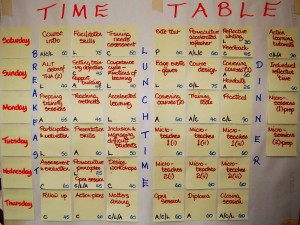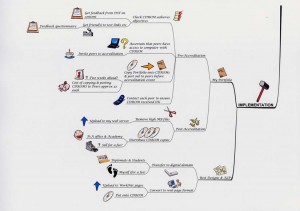by Aranya
Introduction
So now you have created your map, you need to provide your client with an implementation plan. There are several factors that can affect the recommendations you make, including costs, so lets look at them one at a time.
Designing the process
Having looked primarily at how we laid out our design in space, we’ll now consider the dimension of time. Any design drawing provides only a snapshot of how a site might look at a specific stage in its evolution. Nature is of course dynamic; plants grow, trees get bigger & throw more shade, microclimates emerge & habitats change, new plant & animal species appear, big trees fall over & then there’s also of course, climate change to consider…
In addition, the needs of the client may evolve. They may develop an increased dependency upon the site for food or resources, either due to scarcity of them in shops or an increased number of mouths to feed. Or perhaps other local growers surpluses reduce their income from what were previously high-value crops, forcing a change of direction? New people may bring new ideas. The site may be required to fulfil extra or different functions. Neighbours may change & this may bring an increased risk of pollution from the surrounding environment.
Some of these changes can be anticipated & some cannot. Your task is to make your best guess & hopefully provide your client with enough understanding to adapt the design in response to any unexpected changes.
I find a useful tool for designing processes is to use pieces of paper, or sticky notes. 
Course timetable designed using sticky notes
By writing each of the main design processes on a separate piece of paper (much like we did with each element on the base map), they can be moved around on a time grid until we are satisfied they are in the best order. It’s also worth remembering though that if timescales are a bit tight, things often take longer than we originally thought they might!
The following strategies should help you with the decision making process & get you to this point. I usually consider them in this order:
1. Least change for greatest effect
What small thing can you do that will create the most benefit, for the time or resources invested? Often this might be plugging a leak, such as a regular loss of soil, money, or energy. It is always easier to conserve energy than generate more.
Small investments of money that save you more money or resources in the longer term (e.g. building insulation) can free up additional funds to make bigger moneysaving investments. Early successes can encourage further action, so give your client an instant payback & let them see the value of your design advice.
2. Design around the limiting factors
Seasonal constraints must be considered when planting trees or sowing crops. If trees are required & money is also a limiting factor, bare-rooted trees become a good investment. They are cheaper to buy than pot grown trees, but can only be planted safely during the colder winter months ~ so two limiting factors combine to give high priority to winter tree planting. Remember McHarg’s exclusion method? It can be applied to time as well. Identify your most important or most difficult to place elements & put them on your calendar first. Likewise, if you want a good harvest from your garden in the autumn, there is a fairly small window of time (in the spring) in which to sow most of your crops. Seeds too are cheaper than plants.
3. What resources are available & when?
Many limiting factors can become surpluses at other times. For many people with a land-based income, money is much more abundant in the summer & autumn, than in the winter. Conversely though, time may become a key resource when there’s a lot less to do in the garden. Jobs that require a lot of finance or labour should be done when these surpluses are available. A surplus of labour may also bring extra skills. If the site is suitable, running courses is a good way to take advantage of this. As well as potentially providing a financial yield, a practical course can also bring in an expert & a lot of keen volunteer labour to get a big project done.
4. Critical path analysis
There are certain things that need to be done before others, just as a building needs its foundations before its roof. Maybe the client needs to acquire certain skills before tackling a particular task? Sometimes understanding can be gained as part of a ‘trial & error’ process, without the errors leading to any great losses; gardening being a good example. While losing plants is never fun, nature will always give us another chance. Messing up on bigger projects though might prove more costly! Make sure that you place any dependent activity after any that need completing first.
5. Succession & rolling design
Sometimes, the client’s vision will include distinct stages. For example; an initial focus may be upon erecting a building (home?), with an intensive food-producing garden safely out of the way. Then once the building is finished, the intensive garden is moved to zone 1 & a forest garden established where the food garden previously existed. Perhaps this dictates the planting of fruit trees at the beginning & the initial food garden established around them? Having a sense of the different stages, their approximate timescales & how required functions may change, can also help you with creating a rolling design (one where distinct phases are either planned, or evolve over time). Your own observations of the landscape & ability to visualise succession, will enable you to anticipate changing conditions & create a design that evolves to take advantage of them. This is a skill increasingly acquired with experience.
6. Start small & work out from well-managed areas
Set yourself realistic goals – many small successes make you feel good & create added enthusiasm for the task. Chunk big jobs down into smaller pieces.
Mind map of a design implementation plan
Costing
Our implementation plan may also be affected by strategies used to reduce costs ~ both money & time. Each can be key limiting factors, so being able to cost a project is a really valuable skill, especially if you have any intention of designing professionally for other people.
We’ve already considered how costs can be reduced by timely intervention (plugging leaks ~ ‘a stitch in time, saves nine’) or by buying seeds & young trees to save money. It’s also worth remembering though that for some clients time is their greatest limiting factor.
Being able to estimate how much time & / or money each phase of a design may require, will stand you in good stead. Getting into the habit of recording both the financial & time costs of any project you do, will make it easier to give estimates to clients. If for instance, you know the time & materials used in making a raised bed of a given size, you can multiply those figures to obtain a reasonably accurate ‘guesstimate’ for similar situations. As with all these things, practice makes perfect…
Maintaining the design
Well done! Now you can show your client how to best implement the design you have created for them. Don’t forget though, that once it begins to be implemented on the ground, it’s going to require ongoing maintenance. Your remaining task as a designer is to advise your client on how best to do this (in a low-carbon manner!) & help them with evaluating its performance over time (part 9).
- Log in to post comments

